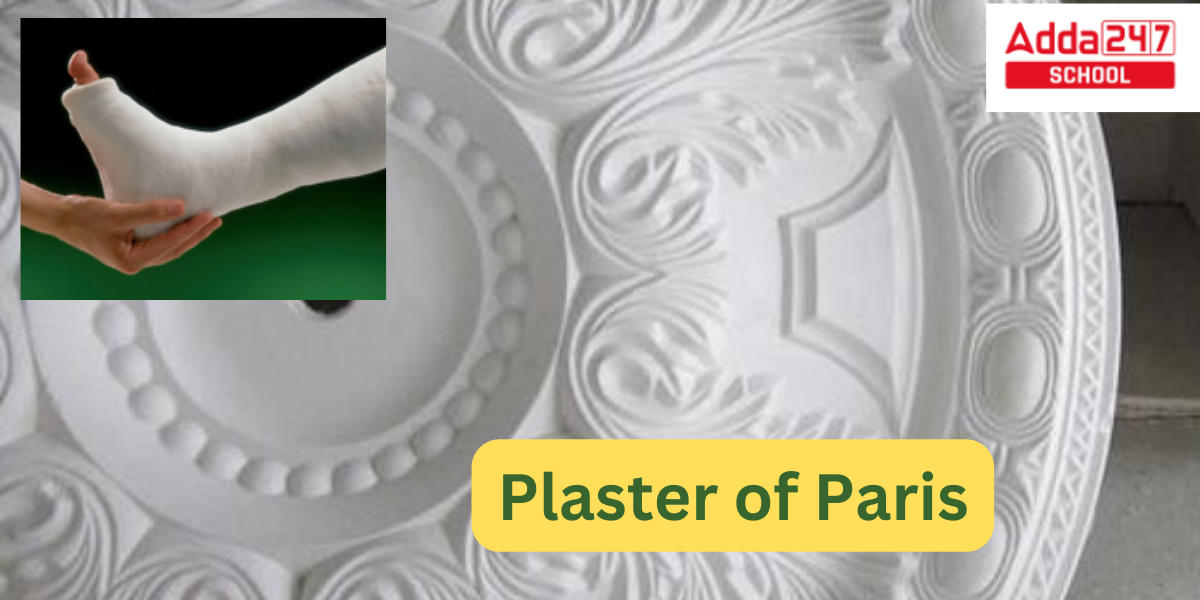Table of Contents
Plaster of Paris
The Plaster of Paris is a material used in construction that may be moulded and cast to create decorative components as well as utilised as a protective or decorative coating for walls and ceilings. In English, “plaster” typically refers to a substance used for inside purposes, whereas “render” frequently alludes to exterior uses. Another ambiguous term for the Plaster of Paris is stucco, which is frequently applied to plasterwork that has been manipulated in some way to create relief embellishment as opposed to flat surfaces.
What is Plaster of Paris
Gypsum, lime, or cement are the key ingredients of the most popular varieties of Plaster of Paris; nonetheless, they all function similarly. The Plaster of Paris is produced as a dry powder that is combined with water right before being applied to the surface to create a stiff yet workable paste. The crystallization process of Plaster of Paris with water releases heat, causing the hydrated Plaster of Paris to solidify.
CaCO3- Chemical & Common Name, Molar & Atomic Mass
Plaster of Paris Formula
Gypsum is heated to roughly 120-180 °C (248-356 °F) in a kiln to generate plaster of Paris, gypsum powder, or plaster of Paris:
When plaster of Paris is moistened with water, it has the extraordinary ability to solidify into a hard mass.
Plaster of Paris is kept in moisture-proof containers since exposure to moisture can cause the material to hydrate, slow down the setting process, and eventually render it worthless.
Plaster of Paris Properties
- Gypsum is created over time when dry plaster powder and water are combined.
- After mixing, the plaster slurry begins to set approximately 10 minutes later and finishes setting in 45 minutes.
- Plaster of Paris expands somewhat when it sets, adding a little bit of volume.
- Plaster of Paris is employed in the production of statues, toys, and other casts.
- Orthorhombic crystals dominate the original matrix, which is the kinetic product.
- Rhombic crystals gradually disappear during the course of the following 72 hours, and the Plaster of Paris becomes stronger and harder as a result.
- Gypsum or Plaster of Paris that has been heated to a temperature between 266°F and 350°F forms hemihydrate, which can then be combined with water to make new gypsum.
The almost water-free form, known as -anhydrite (CaSO4nH2O, where n = 0 to 0.05), is generated when heating to 180 °C (350 °F). Some commercial desiccants take advantage of the fact that anhydrite slowly reacts with water to revert to the dihydrate form. The fully anhydrous form known as -anhydrite or dead burned plaster is created when a substance is heated over 250 °C (480 °F).
Carbon dioxide Formula, Molar Mass and Molecular Weight
Plaster of Paris Uses
- Plaster of Paris may be worked rather readily with metal tools and sandpaper.
- Plaster of Paris can also be moulded, either on the spot or beforehand, and worked portions can be glued into place.
- Plaster of Paris is more suited for finishing than for carrying loads, and when it is placed thickly for decorating, it may necessitate a hidden supporting framework, typically made of metal.
- Plaster of Paris can be used in a variety of additional ways.
- Plaster orthopaedic casts are still often used in medicine to support set fractured bones.
- Plaster of Paris is poured into dental impressions and used to create dental models in dentistry.
- Plaster of Paris is used to create many different kinds of models and moulds.
- The conventional matrix for fresco painting in art is lime plaster; pigments are added to a thin, wet top layer of plaster and fuse with it, resulting in a painting that is actually made of coloured plaster.
Plaster of Paris was frequently employed in the ancient world to make enormous figurative wall reliefs in addition to the ornamental motifs in plaster relief that are still in use today, albeit few of them have survived.
What is Electron Configuration of elements?
Mass of Electron, Proton, and Neutron in g, kg, mev, amu
Uses of Plaster of Paris in History For Class 10
Plaster has been in use for centuries, for heating gypsum, which is a type of mineral. Heating gypsum makes plaster of Paris Chemically known as Calcium sulfate hemihydrate. Yes, exactly what you are thinking, a plaster that is from Paris. Plaster has been in use for centuries, for heating gypsum, which is a type of mineral. Heating gypsum makes plaster of Paris Chemically known as Calcium sulfate hemihydrate. During the 18th century, there was a huge fine in Paris causing a lot of damage to wooden walls. After that, the king ordered to cover all the walls with plaster, to reduce the risk of damage to the people and the infrastructure of Paris from fire. This led to an increase in demand for plaster, although it was used for many centuries this was the first time that it was so much in demand. Paris was the largest producer of gypsum. The mining started in Paris and it was found that it has the Highest amount of gypsum. Since then the name became plaster of Paris.
Read More About:
- Bleaching Powder Formula And Chemical Name
- Area Of Rhombus- Formula And Examples For Class 8
- Rainbow Colours- What Is 7 Rainbow Colours In Order?
- Application For TC By Parents From School/College
Plaster of Paris Characteristics
- Color- white
- Texture- it is in a powder state but when water is added to it gypsum crystals are formed which makes it solid.
- The setting process of Plaster of Paris is exothermic. Exothermic Means it required heat to set. The process of setting plaster of Paris can be catalyzed by sodium chloride. It can be retarded by adding borax or alum.
Uses of Plaster of Paris
Plaster of Paris has been used for many years and with the progress of the years, plaster of plaster has also contributed to making a lot of things easier for humans. Plaster and Paris have developed mostly in the medical field and architecture.
Use of Plaster of Paris in architecture
Architecture is not only about building apartments, industries, or bridges. Architecture is more about aesthetics, the old architecture was so beautiful to look and all of them are still preserved. Plaster of Paris helps in forming different artworks, with the help of moulds, monuments were also made from plaster of Paris and most of the monuments we see around the world are made of plaster of Paris. Used in making the selling of homes which gives a protective coating and a smooth finish.
Use of plaster of Paris in the medical field
Plaster of Paris is used to fix bandages while fixing any fracture which is called bone grafting. It is wrapped around the fractured part with a bandage. It gives a soft surface for the injured part to rest and ensures that the injured party doesn’t move out of the bandage.
Plaster of Paris Advantage
- Easy to use, durable, and lightweight
- Fire-resistant and heat insulator
- Fewer cracks if the best quality of plaster of Paris is used.
- Can work well with surfaces with fibrous material or net material.
- Plaster of Paris is applied to make the surface smooth and plain
- Defects of your walls like corrosion or seepage, after applying plaster of Paris all will vanish
- It will give you are smooth surface to decorate your house wall as you want
- It can be moulded into shapes and made into decorative pieces for houses or doors and windows.
Plaster of Paris Disadvantage
- Plaster of Paris is very costly compared to other materials like cement or lime plaster.
- If you try to do it on your own you might mess up for the first few attempts. It is better to have a professional.
- It is only for the interior not for the exterior.
Plaster of Paris Kya Hai
प्लास्टर ओफ़ पेरिस- यदि आप मूर्तिकला में हैं तो आपको प्लास्टर ऑफ पेरिस से परिचित होना चाहिए। यह एक रासायनिक पदार्थ है जिसका उपयोग मूर्तिकला के लिए किया जाता है और फ्रैक्चर को ठीक करते समय पट्टियों में भी उपयोग किया जाता है। इसे जिप्सम भी कहते हैं।
प्लास्टर ऑफ पेरिस का रासायनिक सूत्र CaSo4.1/2 H2O . है
प्लास्टर ऑफ पेरिस क्या है?- जी हां, बिल्कुल आप क्या सोच रहे हैं, एक प्लास्टर जो पेरिस का है। जिप्सम, जो एक प्रकार का खनिज है, को गर्म करने के लिए प्लास्टर का उपयोग सदियों से होता आ रहा है। जिप्सम को गर्म करने से प्लास्टर ऑफ पेरिस रासायनिक रूप से कैल्शियम सल्फेट हेमीहाइड्रेट के रूप में जाना जाता है। 18वीं सदी के दौरान पेरिस में भारी जुर्माना लगाया गया था जिससे लकड़ी की दीवारों को काफी नुकसान हुआ था। उसके बाद, राजा ने सभी दीवारों को प्लास्टर से ढकने का आदेश दिया, ताकि आग से पेरिस के लोगों और बुनियादी ढांचे को नुकसान के जोखिम को कम किया जा सके। इससे प्लास्टर की मांग में वृद्धि हुई, हालांकि कई शताब्दियों तक इसका उपयोग किया गया था, यह पहली बार था जब इसकी इतनी मांग थी। पेरिस जिप्सम का सबसे बड़ा उत्पादक था। खनन पेरिस में शुरू हुआ और यह पाया गया कि इसमें सबसे अधिक मात्रा में जिप्सम है। तभी से यह नाम प्लास्टर ऑफ पेरिस हो गया।
Plaster of Paris ka Sutra Kya Hai- प्लास्टर ऑफ पेरिस
बनावट- यह पाउडर अवस्था में होता है लेकिन जब इसमें पानी मिलाया जाता है तो जिप्सम क्रिस्टल बनते हैं जो इसे ठोस बनाते हैं।
प्लास्टर ऑफ पेरिस की स्थापना प्रक्रिया ऊष्माक्षेपी है। एक्ज़ोथिर्मिक का मतलब है कि इसे सेट करने के लिए गर्मी की आवश्यकता होती है। प्लास्टर ऑफ पेरिस की स्थापना की प्रक्रिया को सोडियम क्लोराइड द्वारा उत्प्रेरित किया जा सकता है। बोरेक्स या फिटकरी डालकर इसे मंद किया जा सकता है।
प्लास्टर ऑफ पेरिस फॉर्मूला है
जिप्सम को 370-390k पर गर्म किया जाता है।
CaSO4.2H2O + हीट —- CaSO4.0.5H2O + 1.5 H2O
जिप्सम गर्म करने के बाद पानी के अणुओं को खो देता है और इसके परिणामस्वरूप हमें कैल्शियम सल्फेट हेमीहाइड्रेट मिलता है।
यह एक उत्क्रमणीय प्रक्रिया है क्योंकि जब पानी में पानी मिलाया जाता है तो यह फिर से जिप्सम में बदल जाता है।
प्लास्टर ऑफ पेरिस- उपयोग
प्लास्टर ऑफ पेरिस का उपयोग कई वर्षों से किया जा रहा है और वर्षों की प्रगति के साथ, प्लास्टर ऑफ प्लास्टर ने भी मनुष्यों के लिए बहुत सी चीजों को आसान बनाने में योगदान दिया है। प्लास्टर और पेरिस ज्यादातर चिकित्सा क्षेत्र और वास्तुकला में विकसित हुए हैं।
स्थापत्य में प्लास्टर ऑफ पेरिस का प्रयोग
आर्किटेक्चर केवल अपार्टमेंट, उद्योग या पुल बनाने के बारे में नहीं है। वास्तुकला सौंदर्यशास्त्र के बारे में अधिक है, पुरानी वास्तुकला देखने में बहुत सुंदर थी और वे सभी अभी भी संरक्षित हैं। प्लास्टर ऑफ पेरिस विभिन्न कलाकृतियों को बनाने में मदद करता है, सांचों की मदद से स्मारक भी प्लास्टर ऑफ पेरिस से बनाए गए थे और दुनिया भर में हम जितने भी स्मारक देखते हैं, वे प्लास्टर ऑफ पेरिस से बने होते हैं। घरों की बिक्री में उपयोग किया जाता है जो एक सुरक्षात्मक कोटिंग और एक चिकनी खत्म देता है।
चिकित्सा के क्षेत्र में प्लास्टर ऑफ पेरिस का प्रयोग
प्लास्टर ऑफ पेरिस का उपयोग किसी भी फ्रैक्चर को ठीक करते हुए पट्टियों को ठीक करने के लिए किया जाता है जिसे बोन ग्राफ्टिंग कहा जाता है। यह खंडित भाग के चारों ओर एक पट्टी के साथ लपेटा जाता है। यह घायल हिस्से को आराम करने के लिए एक नरम सतह देता है और यह सुनिश्चित करता है कि घायल पक्ष पट्टी से बाहर न जाए।
प्लास्टर ऑफ पेरिस- फायदा
प्रयोग करने में आसान, टिकाऊ और हल्का
आग प्रतिरोधी और गर्मी इन्सुलेटर
यदि प्लास्टर ऑफ पेरिस की सर्वोत्तम गुणवत्ता का उपयोग किया जाए तो कम दरारें।
रेशेदार सामग्री या शुद्ध सामग्री के साथ सतहों के साथ अच्छी तरह से काम कर सकते हैं।
सतह को चिकना और समतल बनाने के लिए प्लास्टर ऑफ पेरिस लगाया जाता है
आपकी दीवारों के दोष जैसे जंग या रिसाव, प्लास्टर ऑफ पेरिस लगाने के बाद सभी गायब हो जाएंगे
यह आपको अपने घर की दीवार को सजाने के लिए चिकनी सतह देगा जैसा आप चाहते हैं
इसे आकृतियों में ढाला जा सकता है और घरों या दरवाजों और खिड़कियों के लिए सजावटी टुकड़ों में बनाया जा सकता है।
प्लास्टर ऑफ पेरिस- नुकसान
प्लास्टर ऑफ पेरिस सीमेंट या चूने के प्लास्टर जैसी अन्य सामग्रियों की तुलना में बहुत महंगा है।
यदि आप इसे स्वयं करने का प्रयास करते हैं तो आप पहले कुछ प्रयासों के लिए गड़बड़ कर सकते हैं। पेशेवर होना बेहतर है।
यह केवल इंटीरियर के लिए है बाहरी के लिए नहीं।



 NEET Admit Card 2025 Release Date by NTA
NEET Admit Card 2025 Release Date by NTA
 UP, MP, CBSE Board Result 2025 Live Upda...
UP, MP, CBSE Board Result 2025 Live Upda...
 NBEMS NEET PG 2025 Registration (Active)...
NBEMS NEET PG 2025 Registration (Active)...

